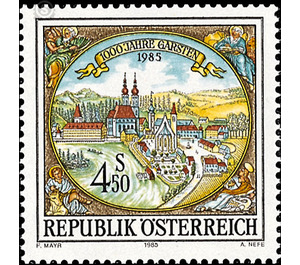1000 years - Austria / II. Republic of Austria 1985 - 4.50 Shilling
Theme: Architecture
| Country | Austria / II. Republic of Austria |
| Issue Date | 1985 |
| Face Value | 4.50 |
| Color | multi-colored |
| Printing Type | combination printing |
| Stamp Type | Commemorative |
| Item Type | Stamp |
| Chronological Issue Number | 1159 |
| Chronological Chapter | OOS-OE2 |
| SID | 392679 |
| In 77 Wishlists | |
Old Bauernsiedelland and at the same time ancient cultural soil combine with the name of the market town Garsten, which celebrated its 1000th anniversary in 1985. The history of Garsten goes back to the Neolithic Age. Finds indicate settlements in the municipality between 2500 and 1800 BC. conclude. Documented is the place name in the record of the synod of Mistelbach near Wels, which was the bishop Pilgrim of Passau between 985 and 991 held for the purpose of the precise determination of the areas subject to mandatory dues. Territorially "Garstina" the Otokaren, the landlords of Styria, which had their seat on the Steaerburg. As the owner of the Parish Garsten Otokar II founded a collegiate and converted this 1107 in a Benedictine monastery. Under the 1st Abbot Berthold (1111-1142), the monastery Garsten took a tremendous upswing. This continued until the 18th century. In 1787, the monastery was abolished by Emperor Josef II, and the place Garsten lost thereby its center. As a result, life changed in Garsten. Housing estates developed on the open fields and meadows around the pin around. In agriculture, the increasing industrialization and mechanization replaced the peasant family. The stamp shows a detail of a copperplate engraving by Georg Matthäus Fischer (1628-1696) showing a view of Garsten.


